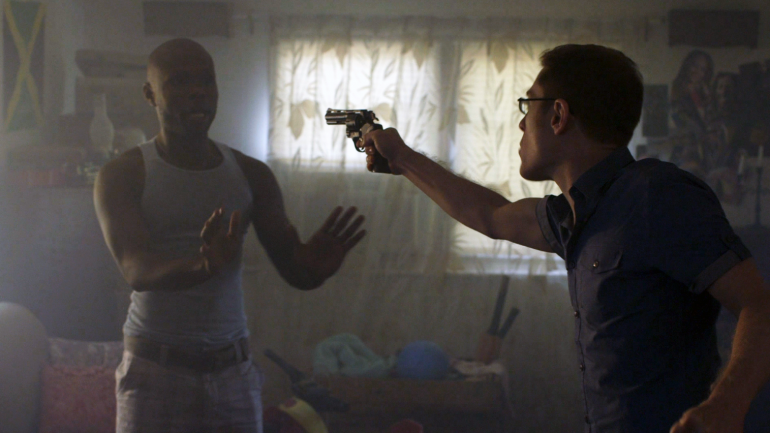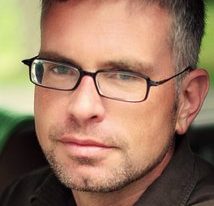 Back to selection
Back to selection
“You Try to Find the Beauty, Shoot It and Move On”: John G. Young on His Microbudget Drama, Bwoy
 Bwoy
Bwoy As Brad, a grief-stricken closeted gay man in upstate New York who becomes increasingly obsessed with a younger Jamaica man (Jimmy Brooks) he meets in an online meat market, Anthony Rapp (Star Trek: Discovery, Rent) is fantastic in writer-director John G. Young’s Bwoy. With a title based on the pronunciation of “boy” in Jamaican patois, the film at first seems like a story of online obfuscation, but it soon grows into a tense meditation on mourning and loss as we discover Brad bears some responsibility for the death of his son and remains in a marriage with Marcia (De’Adre Aziza) that will be forever sullied by its aftermath. Bwoy is both a rich character study of a depressed man as well as a dexterous low-budget thriller in which the uncertainties of identity and the ravages of grief affect a broad range of characters.
Young is an indie film veteran whose previous features include 1995 Sundance entry Parallel Sons and 2005 Tribeca selection The Reception. In Bwoy, he plays out much of the action between his two men on computer and smartphone screens. Like similar-themed pictures Ingrid Goes West and Catfish, Young shows how easy it is to channel repression and self-hatred into an online persona offering a measure of dignity and self-worth to the saddest web 2.0 denizens among us, those whose identities are defined by numbers of likes and retweets.
Bwoy world premiered at the last year’s Reeling, the Chicago LGBTQ International Film Festival before being acquired by Breaking Glass Pictures. It opened in Los Angeles in March and opens in New York, for a week-long run at the Museum of Moving Image, today.

Filmmaker: How did this story of a grief-stricken man who becomes slowly obsessed with this younger man in Jamaica come about?
Young: I feel like the kernel for the story came from a lot of different places. [I was] certainly familiar with being online and the whole concept of how people can build relationships online without ever physically having to meet people, as well the ease at which you can fudge this or that about yourself and how that can slowly snowball into something that you can’t really control. And I’m interested in how people deal with grief. I thought it would be an interesting way to deal with grief — that what you would do is go online and fall down the rabbit hole and let it overtake your life. It’s a way of not confronting your culpability in an accident, in the part that you played in something really awful.
Filmmaker: Once you had the seed of it, how long did the screenwriting process take?
Young: I was working on a project with some people in Los Angeles, a much higher-budgeted film, and I’m realistic about having other films in my back pocket. So as that one was happening I thought, “I’m just gonna write something that I can shoot very very fast on a very small budget that relies on performance and character and story rather than a lot of production value.” And so I started writing. I had a rule — eight locations with the exception of the travel to Jamaica.
Filmmaker: Puerto Rico stands in for Jamaica in this film?
Young: Yeah, because it’s much easier to get into Puerto Rico than Jamaica because you don’t have to go through customs. And I could shoot everything in 24 hours there. So I flew out on a morning, just with Anthony and my camera person, and shot that day, shot the next morning, and then flew back that evening. The character who gives him the gun — he’s a really nice young man who spoke no English and who I found through a casting agency in Puerto Rico. He literally showed up while we were having lunch. I’m like, okay, we’re going to be shooting in an hour. But he was game, good to go. So I figured out something that I could do with very minimal locations, mainly one house. The interior of his house in Jamaica was actually a trailer on the same property as the other house we were shooting in. There was no heat in that trailer, so it was like 40 degrees in there and they’re all in shorts and flip-flops.
I knew the only kind of expensive production element outside of that was going to be bringing Anthony and my camera person to Puerto Rico and shooting all the B roll of the travel to Yenny’s house. I rented it on Airbnb without having seen it. In fact both places were rented on Airbnb. The first one was actually where we stayed — where he kind of walks in and at the end he tosses the card out. The other place, we just rented it, drove up, shot for two and a half hours and left to the airport. So that’s how that worked. [The movie] was shot for about $20,000. And that’s probably all-inclusive at this point. That includes like a little bit of money for mixing and some coloring and so on.
Filmmaker: How did you structure your pay rates on this very low budget?
Young: We actually paid crew on that budget a little bit. They got a small stipend. But the way we were able to do that is to shoot everything in eight days, excluding a return to the house once [the landscape] had gotten green. So that was one day and then the two days in Puerto Rico. So probably a total of eleven days, the whole film. Anthony is onscreen 90% of the time, and his face is the production value. That’s the way I look at it.
Filmmaker: What was the most significant compromise you made during the shoot?
Young: The first half of the film is all on a tripod, and then the camera moves to handheld because as his fever starts to grow and he starts to become more obsessed I wanted the camera to be looser and feel even closer and have a little bit more intimacy, which you get with a handheld camera. So everything is very staid in the beginning. And at some point I think I had written a couple of dolly shots in, and the dolly we had wasn’t working, and I just didn’t have the time to spend to get it working. And one day we shot 15 pages. If you’re working at that pace you’re lucky to get two takes of things. The trick on no money, on that kind of schedule, is to have people who are really good on their first takes.
Anthony, I wasn’t sure how he would react necessarily, but the trick is that the first take is a good take. It’s not a wasted take. The second take is the tweak take and then you move on. Most of the time when there was a little bit more orchestration of stuff I had three takes. But it’s like three takes, setup, do the reverse, move on to your next setup. You have to be very clear about that.
The final scene inside where Anthony walks in and confronts Jimmy was the toughest scene because there were a lot of characters. I had a little girl who was three, and her parents were in the room with us. And of course all she wants to do is run to her parents. We shot her out first, because you want to get her off set as soon as possible, and I was nervous, frankly, because there was a gun on set. It was a fake gun of course, but I was still anxious having little kids around. All of that stuff starts to heighten the time. So that took a little longer. Everything had to be quick and, you know, you try to find the light. You try to find the beauty, try to find the quality of the light and then you shoot it and you move on.
